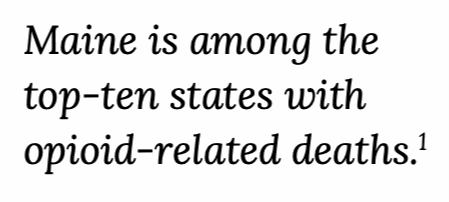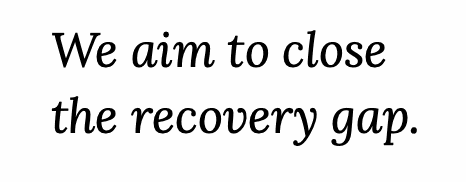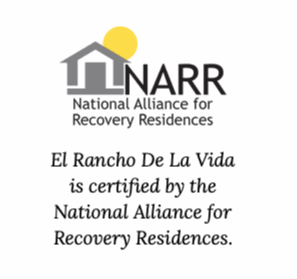Support Radical Hope in Maine.
El Rancho De La Vida is a Maine 501(c)(3) nonprofit corporation. Your contribution is completely tax-deductible. Supporting us is easy by making a gift using our fundraising partner Giving Fuel . Please consider making a monthly contribution— every bit helps.
Maine nonprofit (click to verify) • IRS tax-exemption (click to verify)

Why you should support us
The opioid epidemic is particularly hard-hitting in Maine whose per capita income is just about $31,000 and whose percentage of those living in poverty stands at nearly 12%.[2] With a population of 1.344 million[8], and a federal poverty level of $12,760[9] that means over 170,000 people in Maine live on significantly less than $13,000 annually. In one 2017 sample, Maine was among the top-ten states with opioid-related deaths[1] and that trend is thought to only be further rising. The difficulty faced by those struggling with addiction is a much more hard-hitting, long-lasting, grueling, and insidious crisis.

The Recovery Gap
While not a new model, the concept of recovery residences has grown to fill the deficit mentioned above. These are sometimes also called “sober houses” or “sober living houses”. These are not to be confused with “halfway” houses, which specifically tailor to inmate releases. El Rancho De La Vida views the recovery residence as foundational to a holistic approach to attaining and keeping sobriety.-
Decreased substance use
-
Reduced probability of relapse
-
Lower rates of incarceration
-
Higher income
-
Increased employment rates[4][5][6]
According to the National Alliance of Recovery Residences: “A common predictor of positive outcomes across recovery housing types is the support individuals receive in recovery-oriented communities.

The Stigma Gap

NARR also has strict standards in terms of operating as a “good neighbor”. This standard requires residences to maintain a policy that explicitly outlines how neighbors can share concerns about the residence, and importantly, how staff must respond to those concerns.

A Full Spectrum of Treatment
With this solid foundation, this backbone in mind, El Rancho De La Vida also recognizes that navigating the sea of resources available to the recovering person can be overwhelming and incredibly arduous, especially locating these things:
-
Physicians or physician extensions who prescribe medication-assisted treatment and who have capacity for new patients
-
Mental health treatment in order to effectively diagnose, medicate, and manage mental health issues
-
Drug and alcohol counselors
-
Case managers
-
Like-minded people also in recovery
-
Peer-support navigators
-
Government aid
The Human Spirit
Critically overlooked in our view is the human spirit. Supporting and inspiring the human spirit touches upon all of the dimensions of recovery, it does not necessarily fit neatly within one single dimension. Supporting and inspiring the human spirit means:

-
Discovering one’s potential
-
Giving oneself a sense of purpose
-
Regaining radical hope
-
Nurturing the human need for social contact
-
Being part of something bigger than oneself
-
A sense of pride and of belonging in ‘our house’
And we achieve these things through:
-
Finding work and accomplishing something meaningful, through work therapy
-
Experiencing nature and allowing awe and discovery and emotion, through animal and nature therapy
-
Music therapy
-
Art therapy
-
Self-actualization

A Non-Profit Endevor
Business Model Statement
Our mission is namely sustained by program fees. Our operations and organizational capacity is supported by philanthropy, and by both government and private grants passed on as financial assistance to those we serve. Our program fees are reduced directly by these funding sources to the greatest extent that our financial position permits. Support from these sources are always first directed at reducing client fee to the most in need.
Further reading
William White: Recovery Management and Recovery Oriented Systems of Care
Pew: Medication-Assisted Treatment Improves Outcomes for Patients With Opioid Use Disorder
Global Commission on Drug Policy: Report of the Global Comission on Drug Policy
Cato: Four Decades and Counting: The Continued Failure of the War on Drugs
Kennebec Journal: Maine’s opioid epidemic is far from over
The Atlantic: The War on Drugs: How President Nixon Tied Addiction to Crime
1] National Institute on Drug Abuse. (2019b, March 30). Maine Opioid Summary. Retrieved March 3, 2020, from https://www.drugabuse.gov/opioid-summaries-by-state/maine-opioid-summary
[2] U.S. Census Bureau. (n.d.). U.S. Census Bureau QuickFacts: Maine. Retrieved March 1, 2020, from https://www.census.gov/quickfacts/fact/table/ME/HSG010218
[3] Substance Abuse and Mental Health Services Administration. (2012). SAMHSA’s working definition of recovery. Rockville, MD: Center for Mental Health Services, Substance Abuse and Mental Health Services Administration, U.S. Department of Health and Human Services. Retrieved from https://store.samhsa.gov/product/SAMHSA-s-Working-Definition-of-Recovery/PEP12-RECDEF
[4] Laudet, A. B., & Humphreys, K. (2013). Promoting recovery in an evolving policy context: What do we know and what do we need to know about recovery support services Journal of Substance Abuse Treatment, 45(1), 126–133. http://dx.doi.org/10.1016/j.jsat.2013.01.009
[5] Mericle, A. A., Miles, J., & Way, F. (2015). Recovery residences and providing safe and supportive housing for individuals overcoming addiction. Journal of Drug Issues, 45(4), 368–384. http://dx.doi.org/10.1177/0022042615602924
[6] Polcin, D. L., Korcha, R. A., Bond, J., & Galloway, G. (2010). Sober living houses for alcohol and drug dependence: 18-month outcomes. Journal of Substance Abuse Treatment, 38(4), 356–365. http://dx.doi.org/10.1016/j.jsat.2010.02.003
[7] NARR Compendium C v6, published March 2019
[8] U.S. Census Bureau. (n.d.). U.S. Census Bureau QuickFacts: Maine. Retrieved April 12, 2020, from https://www.census.gov/quickfacts/ME
[9] U.S. Centers for Medicare & Medicaid Services. (n.d.). Federal Poverty Level (FPL). Retrieved April 12, 2020, from https://www.healthcare.gov/glossary/federal-poverty-level-fpl/